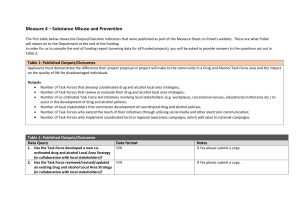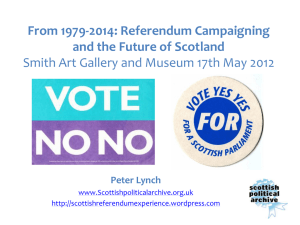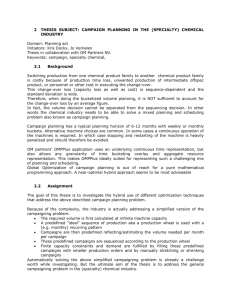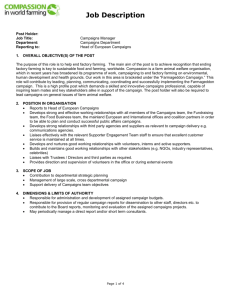Background paper – Working session 2.2 Are electoral costs
advertisement
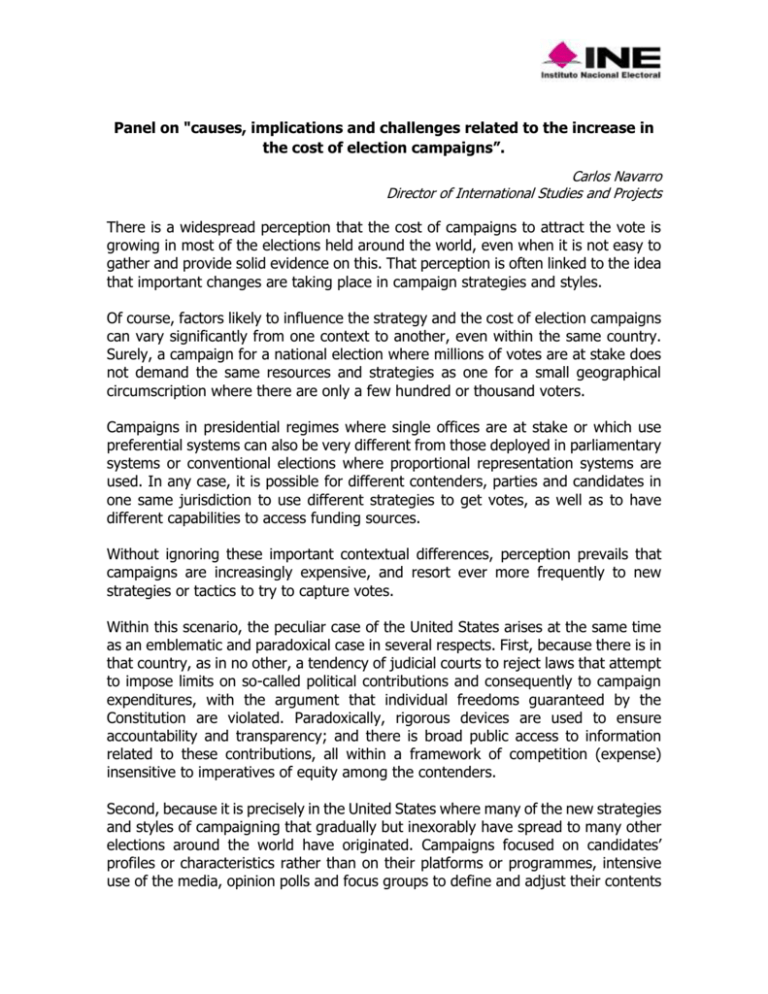
Panel on "causes, implications and challenges related to the increase in the cost of election campaigns”. Carlos Navarro Director of International Studies and Projects There is a widespread perception that the cost of campaigns to attract the vote is growing in most of the elections held around the world, even when it is not easy to gather and provide solid evidence on this. That perception is often linked to the idea that important changes are taking place in campaign strategies and styles. Of course, factors likely to influence the strategy and the cost of election campaigns can vary significantly from one context to another, even within the same country. Surely, a campaign for a national election where millions of votes are at stake does not demand the same resources and strategies as one for a small geographical circumscription where there are only a few hundred or thousand voters. Campaigns in presidential regimes where single offices are at stake or which use preferential systems can also be very different from those deployed in parliamentary systems or conventional elections where proportional representation systems are used. In any case, it is possible for different contenders, parties and candidates in one same jurisdiction to use different strategies to get votes, as well as to have different capabilities to access funding sources. Without ignoring these important contextual differences, perception prevails that campaigns are increasingly expensive, and resort ever more frequently to new strategies or tactics to try to capture votes. Within this scenario, the peculiar case of the United States arises at the same time as an emblematic and paradoxical case in several respects. First, because there is in that country, as in no other, a tendency of judicial courts to reject laws that attempt to impose limits on so-called political contributions and consequently to campaign expenditures, with the argument that individual freedoms guaranteed by the Constitution are violated. Paradoxically, rigorous devices are used to ensure accountability and transparency; and there is broad public access to information related to these contributions, all within a framework of competition (expense) insensitive to imperatives of equity among the contenders. Second, because it is precisely in the United States where many of the new strategies and styles of campaigning that gradually but inexorably have spread to many other elections around the world have originated. Campaigns focused on candidates’ profiles or characteristics rather than on their platforms or programmes, intensive use of the media, opinion polls and focus groups to define and adjust their contents or messages, use of new techniques for political marketing and image consultants, and often, launching negative campaigns against opponents. Of course, not all campaigns within or outside the United States exhibit such characteristics, but they do mark a dominant trend or an ideal reference in the minds of many contestants and their strategists. Third, because it is in the US where systematic records documenting this apparent upward spiral in campaign expenses were generated. Between 2000 and 2012, the estimated cost of federal campaigns (presidential and congressional) went from 3 to just over 6 billion dollars. The paradox lies in the fact that while the American styles for campaigning are replicated in many other places, almost none of them has systematic or reliable records on the volume, source and application of the funds invested in them. In any case, from a broader perspective, the debate on the costs of election campaigns is raised in a scenario where elections are becoming increasingly pluralistic and competitive around the world. It is in this context where a handful of votes may make the difference between victory and defeat, and where reflection and debate on the implications, challenges and risks involving new campaign formats or styles, as well as on the alleged upward spiral in their costs makes more sense, especially for the purposes of this panel. Cases everywhere refute the thesis that the candidate who spends the most on a campaign or makes a major investment in media propaganda is the one most likely to win an election, making such thesis very questionable. However, there is no doubt that if the contestants and their advisors or campaign strategists share the idea that the more you invest in a campaign and the more media visibility you have, the better your expectations of success, then channels open to detonate a upward spiral in costs. At the same time, they tend to generate larger concerns and demands related to the regulation and control of the expenses of the campaign, either because of the imperatives linked to the accountability and transparency of the origin of the funds, or because of the conditions of equality of competition for the vote. Guided by these or other equally legitimate reasons, many countries have adopted and tried to implement legal measures aimed at controlling campaign expenditures. Setting ceilings to campaign expenditures is among the most common ones. At first glance, this seems to be a reasonable solution; but as soon as the matter is examined with a little detail and we reflect, for instance, in the areas of expense comprehended in this limit, in the subjects they apply to, or in the resources or mechanisms at hand to ensure compliance, things can become very complicated. In a more practical sense, some regulations impose limits only on specific fields that are not only considered as important expenditure triggers, such as the amount or volume of advertising that can be broadcast in the media, but also leave auditable traces or tracks to facilitate their monitoring and quantification. There are others that are less likely to directly influence the dynamics of spending, such as reducing the deadlines for campaign activities or those to disseminate propaganda in the mass media. In any case, the effectiveness of these measures to contain campaign expenditures, as well as the reliability or accuracy of the information reported, are debatable issues. This, because despite the progress which has undoubtedly taken place in the field of regulation and control of party and campaign financing, the amount of resources that are actually assigned to those ends remains controversial and hazy. The issue becomes even more delicate when considerations related to those resources invested in illegal actions like vote buying or coercion of the voters - of course, never revealed publicly - are incorporated to the reflection and debate. As we can see, there are enough reasons for the organizing institutions to include a panel on the causes, implications and challenges that entail an upward spiral in campaign expenditures in a global forum dedicated to sharing knowledge, experiences and possible solutions to some of the dilemmas posed by the complex relationship between money and politics. Following an interview-panel format, four specialists, one serving as conductorinterviewer and the other three as presenters of experiences in a regional comparative perspective, are expected to provide data and insights that may lead towards a comprehensive understanding and the proper assessment of this issue; as well as to provide elements that may expand or open channels for investigation and analysis. This will have a starting point in their answers and positioning to such questions as: What evidence supports the idea that the costs of electoral campaigns are systematically increasing around the globe? What are the driving factors of this trend? Which are some of its implications? Does this raise serious issues of concern? Is it desirable/feasible to contain this tendency? If so, what type of regulations or measures can be adopted to properly tackle this issue? What has been effective in terms of lowering the cost of elections? Should EMB´s play a major role in this regard? What lessons have been learnt from an institutional point of view? What are the perspectives? What comes next?
